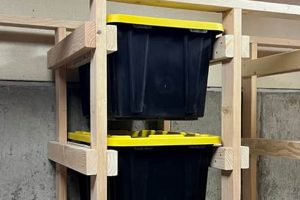The resourceful repurposing of shipping platforms into inventive organizational systems for implements represents an exercise in sustainable practicality. This approach integrates the principles of do-it-yourself fabrication with a focus on maximizing spatial efficiency in workshops or garages. An example of this would be dismantling a wooden skid and reassembling its components to create a wall-mounted rack specifically designed to hold screwdrivers, hammers, and other hand tools.
The significance of this method lies in its accessibility, affordability, and environmental responsibility. It provides a cost-effective alternative to commercially manufactured storage solutions, reducing reliance on new materials and diverting waste from landfills. Historically, such resourcefulness has been a hallmark of self-sufficiency, reflecting a desire to create functional solutions from readily available resources.
This article will now delve into specific design considerations, construction techniques, and finishing options for constructing tool storage solutions from reclaimed shipping platforms, offering practical guidance for readers seeking to implement these organizational strategies in their own spaces.
Practical Guidance for Pallet-Based Tool Organization
Effective implementation of repurposed shipping platforms for tool management requires careful planning and execution. The following tips offer actionable advice for maximizing the utility and longevity of these storage systems.
Tip 1: Pallet Selection: Source pallets designated as “HT” (heat treated) and avoid those marked “MB” (methyl bromide), as the latter indicates a potentially hazardous fumigation process. Inspect carefully for damage, rot, or infestation prior to use.
Tip 2: Disassembly Safety: Wear appropriate personal protective equipment, including gloves and eye protection, during disassembly. Use a reciprocating saw or specialized pallet buster tool to minimize wood splitting and ensure controlled separation of components.
Tip 3: Design for Accessibility: Consider the tools to be stored when designing the layout. Position frequently used items within easy reach. Employ angled shelves or tiered arrangements for improved visibility and access.
Tip 4: Secure Mounting: Ensure stable and secure attachment of the storage unit to a wall or other support structure. Use appropriate fasteners rated for the weight of the tools and the construction material of the mounting surface. Consider weight distribution to prevent overload.
Tip 5: Surface Treatment: Apply a sealant, paint, or stain to protect the wood from moisture and wear. This not only enhances durability but also improves the aesthetic appeal. Consider a clear coat to preserve the natural wood grain.
Tip 6: Labeling and Organization: Implement a clear labeling system to identify the contents of each storage section. This promotes efficient tool retrieval and reduces time spent searching. Color-coding can further enhance organization.
Tip 7: Customized Inserts: Create custom-fitted inserts from foam, wood, or other materials to securely hold individual tools in place. This prevents damage and promotes organized storage.
These strategies will contribute to the creation of a functional, safe, and visually appealing tool storage system, maximizing the benefits of repurposed shipping platforms. The subsequent sections will address long-term maintenance and potential modifications.
1. Sustainability
The integration of sustainability principles into tool storage solutions addresses growing concerns regarding resource depletion and environmental impact. The repurposing of discarded shipping platforms directly contributes to waste reduction and promotes a circular economy model.
- Waste Diversion
Utilizing discarded shipping platforms for tool storage diverts these materials from landfills, reducing the volume of waste requiring disposal. This minimizes the environmental burden associated with landfill operation, including methane emissions and land degradation. An example is transforming damaged platforms, which would otherwise be discarded, into functional wall-mounted tool organizers.
- Reduced Demand for New Materials
Employing reclaimed wood reduces the demand for newly harvested timber, conserving forest resources and minimizing deforestation. This translates to decreased energy consumption and pollution associated with logging, transportation, and processing of virgin wood. A shop owner might choose pallet wood over new lumber for a shelving unit, decreasing their reliance on resource extraction.
- Lower Carbon Footprint
Reusing existing materials minimizes the carbon footprint compared to manufacturing new storage solutions. The energy expenditure associated with processing, manufacturing, and transporting new materials is significantly reduced. A comparative analysis could show that a pallet-based system has a carbon footprint drastically lower than a steel cabinet.
- Promotion of Resourcefulness
The utilization of discarded materials encourages a mindset of resourcefulness and creativity. It demonstrates the potential for transforming waste into valuable resources, promoting a more sustainable approach to consumption and production. Many artisans showcase their pallet-based storage solutions, inspiring others to upcycle and reduce waste.
These considerations demonstrate that the utilization of shipping platforms for tool storage not only provides a practical solution but also embodies a commitment to environmental stewardship. The convergence of functionality and sustainability offers a compelling argument for adopting this approach in various workshop and storage environments.
2. Accessibility
Accessibility, in the context of tool storage, refers to the ease and efficiency with which tools can be located, retrieved, and returned to their designated positions. For “clever diy tool storage using pallets,” accessibility is a crucial design consideration, directly impacting the system’s usability and effectiveness. A pallet-based system that is poorly organized, with tools obscured or difficult to reach, negates its potential benefits. The arrangement must facilitate rapid identification and retrieval of necessary implements. For instance, a wall-mounted pallet rack with clearly labeled compartments for each tool type promotes visual accessibility. Similarly, a tiered system allows for easy access to tools stored at different levels. Without this focus, time is wasted searching for tools, diminishing overall productivity and potentially leading to unsafe practices.
The strategic placement of tool storage units is also integral to accessibility. A system located close to the primary work area minimizes unnecessary movement and streamlines workflow. Mobile pallet-based carts, equipped with casters, offer further advantages by allowing users to bring the required tools directly to the task at hand. Careful consideration must be given to the physical characteristics of the user, ensuring that the storage system is accessible to individuals of varying heights and reach capabilities. For example, tools frequently used by an individual should be placed at a height that does not require excessive bending or stretching. Implementing a system that accommodates such ergonomic factors enhances both efficiency and safety.
In summary, the degree to which a pallet-based tool storage system is accessible directly determines its value. Careful planning, strategic tool placement, and user-centered design are paramount. Neglecting accessibility results in a disorganized and inefficient workspace, undermining the potential advantages of this resource-conscious storage approach. Successfully integrating accessibility transforms a rudimentary pallet structure into a functional and efficient tool management solution, positively impacting workflow, productivity, and safety.
3. Structural Integrity
The structural integrity of repurposed shipping platforms, when utilized for tool storage, directly impacts the safety and longevity of the organizational system. A compromised structure introduces the risk of collapse, potentially damaging tools and causing injury. The cause of structural failure often stems from the inherent variability in pallet quality, previous wear and tear, and improper construction techniques. The importance of robust construction becomes apparent when considering the cumulative weight of the tools the pallet structure must support. Example: A wall-mounted shelf crafted from deteriorated pallet wood may buckle under the load of heavy power tools, creating a hazardous situation. The practical significance of this understanding necessitates a thorough inspection of pallet components, reinforcement where necessary, and the application of appropriate load-bearing calculations during construction.
Further emphasizing the point, structural integrity considerations extend beyond the wood itself to encompass the joining methods employed. Securing components with inadequate fasteners or neglecting to reinforce stress points inevitably leads to premature failure. For example, using insufficient screws to attach a heavy drawer slide to a pallet-wood frame can result in the drawer detaching under load. Practical application involves the selection of screws, bolts, or nails appropriate for the wood type and the anticipated weight. Reinforcement techniques such as adding corner braces or applying structural adhesive can significantly enhance the load-bearing capacity and overall stability of the system. Moreover, the method of attachment to the wall is equally critical, requiring anchors rated for the combined weight of the storage unit and its contents.
In conclusion, the structural integrity of pallet-based tool storage is not merely an aesthetic consideration but a fundamental requirement for safety and durability. Challenges arise from the inherent variability in pallet materials and the need for meticulous construction techniques. By prioritizing careful material selection, employing robust joining methods, and understanding load-bearing principles, the risks associated with structural failure can be mitigated, transforming discarded shipping platforms into reliable and efficient organizational solutions. The overall effectiveness and longevity of these DIY projects hinge on a comprehensive understanding and application of structural integrity principles.
4. Spatial Efficiency
Spatial efficiency, in the context of tool organization, denotes the maximization of storage capacity within a confined area. Repurposing shipping platforms for tool storage directly addresses spatial constraints, offering a customizable solution for workshops, garages, or sheds where available space is often limited. A direct correlation exists between the design of the pallet-based system and its ability to optimize available area. Cause: ineffective design and over-sized structures result in under-utilized space. Effect: wasted space and inhibited movement within the designated work environment. The importance of spatial efficiency as a component stems from its impact on workflow and overall usability of the storage system. Consider a small garage where floor space is at a premium. Building wall-mounted shelving from pallet wood frees up valuable floor area for other activities, improving work conditions. The designs contribution enhances both the available work area and reduces clutter which minimizes the opportunity for work-related accidents. Real-life examples demonstrating spatial efficiency include creating narrow, vertical tool racks for long-handled implements or constructing compact storage units that fit beneath workbenches. The practical significance of maximizing spatial efficiency with repurposed shipping platforms extends beyond mere organization; it directly influences productivity, safety, and the overall functionality of the workspace.
Further, the modular nature of these systems facilitates adaptation to varying spatial configurations. Components can be easily reconfigured, added, or removed to accommodate changing tool collections or workflow requirements. This adaptability contrasts with fixed, commercially manufactured storage solutions, which often lack the flexibility to evolve with the user’s needs. For instance, a system initially designed for hand tools can be modified to accommodate power tools by adding larger compartments or reinforced shelves. This versatility is a key advantage in dynamic work environments where storage needs evolve over time. The utilization of every available space is essential. Awkward corners can be used for storing larger tools. Designing the system to extend to the ceiling also increases the storage capability.
In summary, spatial efficiency is a fundamental design principle in “clever diy tool storage using pallets”. In contrast to commercially built storage solutions, repurposing shipping platforms provides design and spatial versatility. Optimization requires careful planning, the use of narrow spaces, using ceiling space, and an understanding of the storage needs in the workshop, garage, or shed. By prioritizing spatial efficiency, and making full use of the space provided, these DIY solutions contribute to a more organized and productive workspace. The modular nature of a pallet system enhances design and space-saving capabilities.
5. Cost-Effectiveness
The economic advantages of utilizing discarded shipping platforms for tool storage constitute a significant driver for its adoption. This approach presents a compelling alternative to purchasing commercially manufactured storage solutions, typically incurring substantial expenses. The appeal resides primarily in the accessible and often free nature of the raw materials.
- Reduced Material Expenditure
The primary cost saving derives from the acquisition of shipping platforms. These are often available at no cost from businesses seeking to dispose of them. Even when a small fee is involved, it is considerably less than the price of lumber or manufactured storage units. The reduction in material expenditure directly translates into lower project costs, particularly beneficial for individuals on a budget. An example is obtaining pallets from a local business and using them to build a wall-mounted tool organizer, bypassing the need to buy expensive shelving units.
- Minimized Labor Costs
While the construction process requires time and effort, the DIY nature of the project eliminates the need for professional installation. The labor is contributed by the individual undertaking the project, representing a cost saving. The DIY approach promotes skill-building and empowerment. For instance, a homeowner constructs a tool storage system during their leisure time, avoiding the expense of hiring a carpenter.
- Lower Maintenance Expenses
Pallet wood, once properly treated, is generally durable and requires minimal maintenance. Repairs, when necessary, can be easily undertaken using readily available and inexpensive materials. The relative simplicity of the structures lowers the potential for complex repairs. Maintaining the finish prolongs the lifespan of the structure with little cost. Pallet wood can withstand a garage environment. A regular cleaning and re-application of sealant, if necessary, will provide a cost-effective solution.
- Resource Optimization
The repurposing of shipping platforms aligns with principles of resource optimization and sustainability. It reduces the demand for new materials, thereby minimizing the environmental impact and promoting a circular economy. While not a direct monetary saving, the responsible use of resources contributes to long-term economic and environmental benefits. An example is reducing carbon footprint by not purchasing lumber. This is an indirect cost-saving measure.
The aggregate effect of reduced material expenditure, minimized labor costs, lower maintenance expenses, and resource optimization renders repurposed shipping platforms a highly cost-effective solution for tool storage. The combination of practicality, affordability, and environmental responsibility underscores the benefits of this approach. It allows individuals to achieve effective organization without incurring significant financial strain.
6. Customization
The inherent adaptability of shipping platforms makes them particularly well-suited for customized tool storage solutions. This inherent flexibility allows for the tailoring of storage configurations to meet the specific needs of individual users and workspaces, surpassing the limitations of standardized, commercially produced options.
- Tool-Specific Accommodation
The dimensions and structure of pallet wood can be modified to create compartments precisely sized for individual tools or tool sets. This ensures secure and organized storage, preventing damage and facilitating easy retrieval. For example, a dedicated slot can be constructed to house a specific power drill and its accessories, ensuring all components remain together. This reduces clutter and minimizes search time.
- Spatial Adaptation
The modular nature of pallet-based systems enables adaptation to varying spatial constraints. Storage units can be constructed to fit into tight corners, beneath workbenches, or along walls, maximizing the utilization of available space. This adaptability is particularly valuable in small workshops or garages where space is at a premium. An example would be designing a narrow, vertical storage rack to fit in an unused space between a workbench and a wall.
- Ergonomic Considerations
Customization allows for the incorporation of ergonomic design principles, optimizing accessibility and reducing strain. Storage units can be positioned at appropriate heights and angles to minimize bending, reaching, and lifting. This enhances user comfort and promotes safety. An example is building a rolling tool cart with a handle positioned at a comfortable height, minimizing back strain during movement.
- Personalized Aesthetics
Beyond functional adaptations, customization allows for the incorporation of personal aesthetic preferences. Pallet wood can be painted, stained, or decorated to match the surrounding environment or reflect the user’s individual style. This transforms the storage system from a purely utilitarian object into a visually appealing element within the workspace. An example is applying a vibrant color scheme to a pallet-based tool organizer to complement the existing workshop dcor.
The confluence of tool-specific accommodation, spatial adaptation, ergonomic considerations, and personalized aesthetics underscores the transformative potential of customization in “clever diy tool storage using pallets”. This adaptability is a primary reason for the enduring popularity of this approach among DIY enthusiasts and professionals alike, demonstrating its capacity to generate uniquely efficient and aesthetically pleasing storage solutions.
Frequently Asked Questions
The following addresses common inquiries regarding the construction and utilization of tool storage systems crafted from repurposed shipping platforms. These answers aim to provide clarity and guidance for those considering this approach.
Question 1: Are all shipping platforms suitable for tool storage construction?
No. Pallets designated with an “MB” stamp, indicating methyl bromide fumigation, should be avoided due to potential health risks. Heat-treated (“HT”) pallets are a safer alternative. Further, all pallets should be thoroughly inspected for damage, rot, and infestation before use.
Question 2: What is the recommended method for disassembling shipping platforms?
The safest and most efficient method involves using a reciprocating saw or a specialized pallet-buster tool. These tools minimize the risk of wood splitting and injury. Personal protective equipment, including gloves and eye protection, must be worn during disassembly.
Question 3: How can the structural integrity of a pallet-based tool storage system be ensured?
The use of high-quality fasteners, such as screws or bolts, is essential. Reinforcement techniques, such as adding corner braces or applying structural adhesive, can further enhance stability. The method of attachment to the wall or other support structure must also be carefully considered.
Question 4: What surface treatments are appropriate for pallet wood used in tool storage?
A sealant, paint, or stain can protect the wood from moisture and wear. These treatments not only enhance durability but also improve the aesthetic appeal. Consider a clear coat to preserve the natural wood grain.
Question 5: How can accessibility be optimized in a pallet-based tool storage system?
Strategic placement of tools, clear labeling, and the incorporation of ergonomic design principles are essential. Frequently used items should be positioned within easy reach, and the system should accommodate users of varying heights and reach capabilities.
Question 6: What are the long-term maintenance requirements for pallet-based tool storage?
Regular cleaning and inspection are recommended. Damaged components should be repaired or replaced promptly. Re-application of surface treatments may be necessary to maintain protection against moisture and wear.
These responses provide a foundation for understanding the essential considerations involved in constructing and maintaining tool storage systems from repurposed shipping platforms. Adherence to these guidelines will contribute to the creation of a functional, safe, and durable storage solution.
The subsequent section will explore advanced design techniques and innovative applications of pallet wood in tool storage.
Conclusion
The preceding exploration of “clever diy tool storage using pallets” has underscored the practicality, sustainability, and adaptability inherent in this organizational approach. This method offers a cost-effective alternative to commercially manufactured solutions, while simultaneously promoting resourcefulness and reducing environmental impact. Successful implementation hinges on careful material selection, robust construction techniques, and a user-centered design that prioritizes accessibility and spatial efficiency. The adaptability of repurposed shipping platforms allows for a high degree of customization, ensuring that the final product aligns precisely with individual needs and workspace constraints.
As individuals and organizations increasingly seek sustainable and economical solutions, the resourceful repurposing of discarded materials, such as shipping platforms, is poised to gain further traction. The potential to transform waste into functional and aesthetically pleasing organizational systems represents a compelling argument for embracing this approach. The continued innovation and refinement of these techniques promises to unlock even greater efficiencies and aesthetic possibilities in the realm of tool management, contributing to more organized, productive, and environmentally conscious work environments.







![Build Your Own! Storage Bin Rack DIY Project [Easy] The DIY Hub: Creative Crafts, Repairs & Life Hacks Build Your Own! Storage Bin Rack DIY Project [Easy] | The DIY Hub: Creative Crafts, Repairs & Life Hacks](https://craftingdiycenter.com/wp-content/uploads/2025/07/th-1825-300x200.jpg)